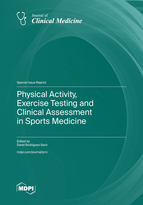Physical Activity, Exercise Testing and Clinical Assessment in Sports Medicine
A special issue of Journal of Clinical Medicine (ISSN 2077-0383). This special issue belongs to the section "Sports Medicine".
Deadline for manuscript submissions: closed (31 December 2022) | Viewed by 74663
Special Issue Editor
Interests: foot; ligaments; muscles; musculoskeletal disorders; sports; tendons; ultrasonography
Special Issues, Collections and Topics in MDPI journals
Special Issue Information
Dear Colleagues,
Physical activity and exercise testing are two key points in sports medicine. Sports medicine is a field of medicine concerned with the prevention and treatment of injuries and disorders that are related to participation in sports. Clinical assessment in sports medicine can solve so many questions about diagnosis, treatment, and prognosis about health in sports.
Physical activity could be defined as any bodily movement produced by skeletal muscles that requires energy expenditure. Physical activity refers to all movement including during leisure time, for transport to get to and from places, or as part of a person’s work. Both moderate- and vigorous-intensity physical activity improve health. Regular physical activity is proven to help prevent and manage noncommunicable diseases such as heart disease, stroke, diabetes, and several cancers. It also helps prevent hypertension, maintain healthy body weight, and can improve mental health, quality of life, and well-being. Exercise could be defined a subset of physical activity that is planned, structured, and repetitive and has as a final or an intermediate objective the improvement or maintenance of physical fitness. Gait and posture analysis, clinical assessment, biomechanical analysis, reliability and repeatability research, force platform and electromyography analysis are key points in order to achieve a better knowledge in this area.
This Special Issue promotes new research procedures about physical activity, exercise testing, and clinical assessment in sports medicine in order to achieve the right health interventions in sport.
Dr. David Rodríguez-Sanz
Guest Editor
Manuscript Submission Information
Manuscripts should be submitted online at www.mdpi.com by registering and logging in to this website. Once you are registered, click here to go to the submission form. Manuscripts can be submitted until the deadline. All submissions that pass pre-check are peer-reviewed. Accepted papers will be published continuously in the journal (as soon as accepted) and will be listed together on the special issue website. Research articles, review articles as well as short communications are invited. For planned papers, a title and short abstract (about 100 words) can be sent to the Editorial Office for announcement on this website.
Submitted manuscripts should not have been published previously, nor be under consideration for publication elsewhere (except conference proceedings papers). All manuscripts are thoroughly refereed through a single-blind peer-review process. A guide for authors and other relevant information for submission of manuscripts is available on the Instructions for Authors page. Journal of Clinical Medicine is an international peer-reviewed open access semimonthly journal published by MDPI.
Please visit the Instructions for Authors page before submitting a manuscript. The Article Processing Charge (APC) for publication in this open access journal is 2600 CHF (Swiss Francs). Submitted papers should be well formatted and use good English. Authors may use MDPI's English editing service prior to publication or during author revisions.
Keywords
- Physical activity
- Exercise
- Clinical assessment
- Biomechanics
- Sports







